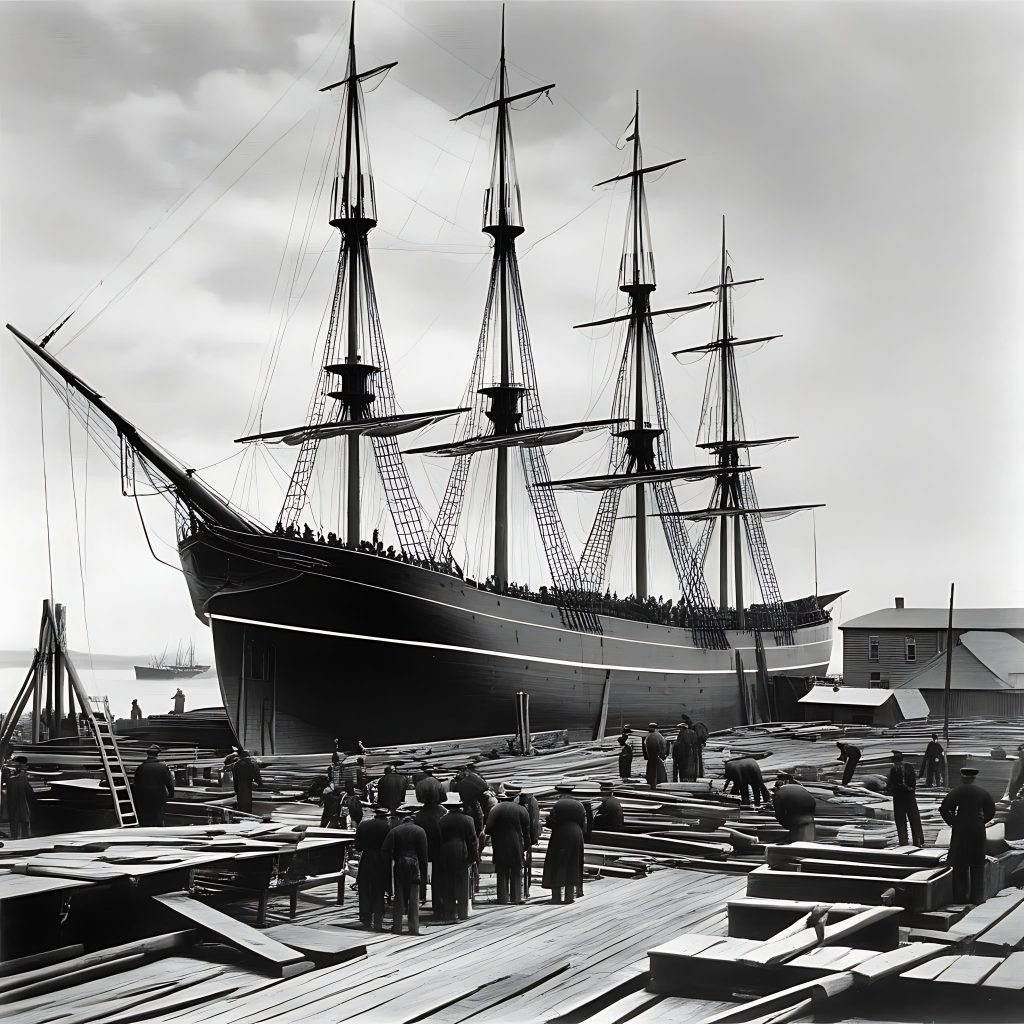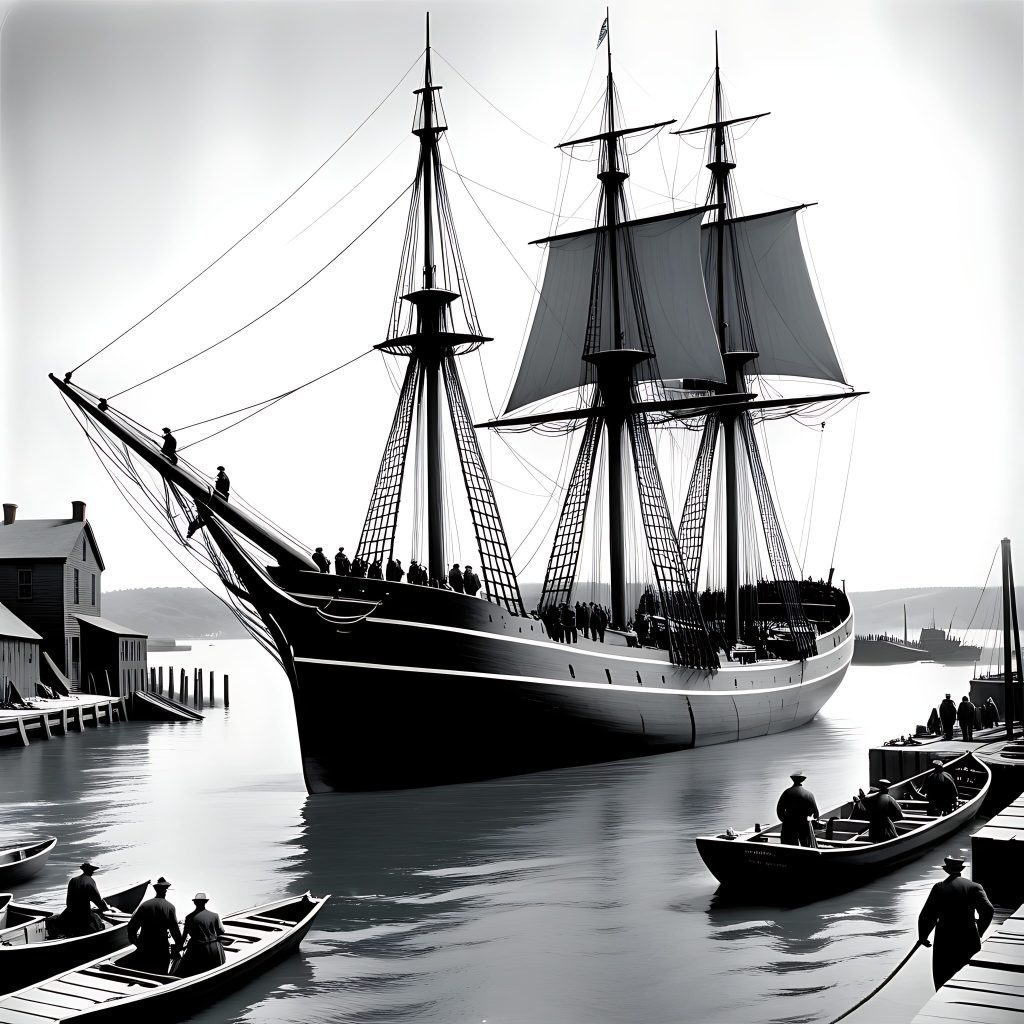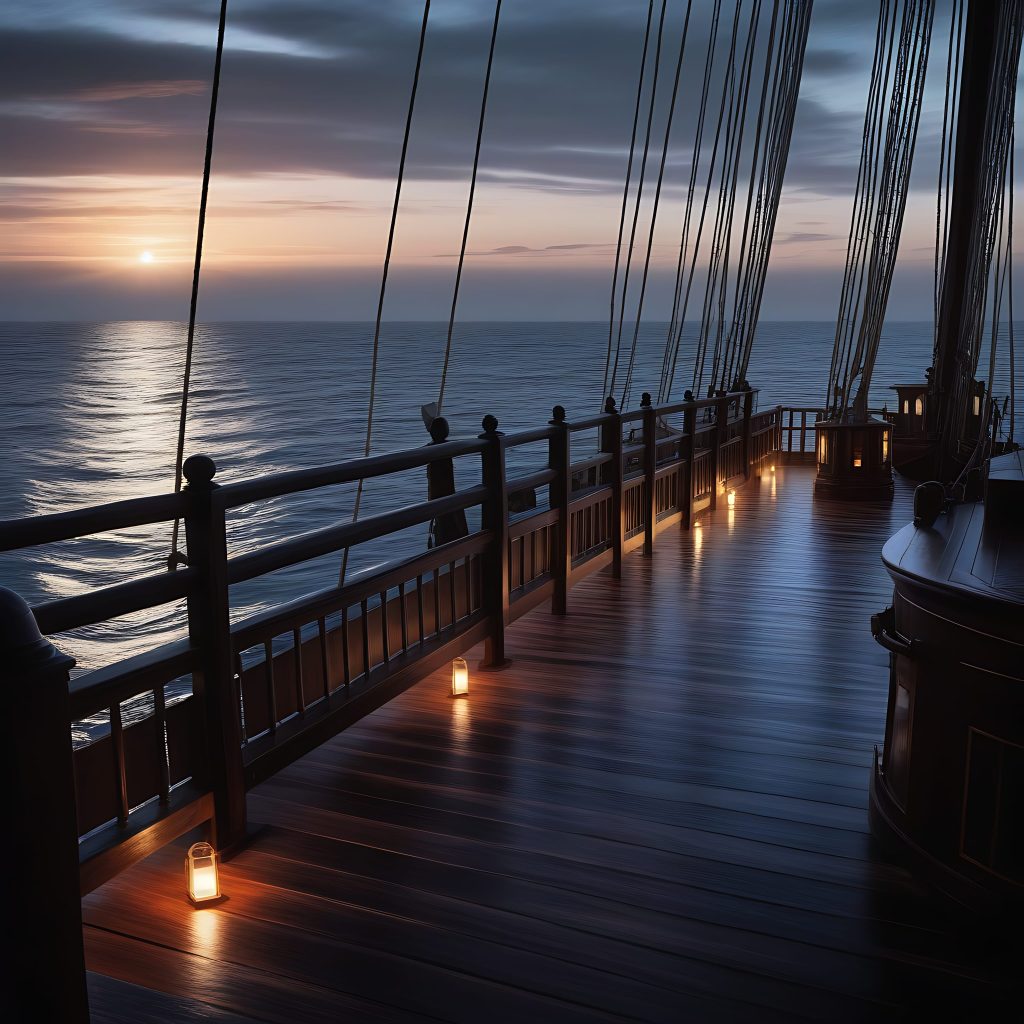Amidst the vast expanse of the Atlantic Ocean’s treacherous embrace, the Mary Celeste stood silent, her sails partially set against the December sky of 1872. This American brigantine, now an eerie specter of a vessel, drifted—her crew mysteriously vanished as if swallowed by the sea itself. The Mary Celeste would become one of the most baffling ghost ship legends to ever haunt the annals of maritime history, a riddle wrapped in the deep blue’s unfathomable depths.
This vessel’s tale is steeped in enigma and has become the quintessential ghost ship narrative, permeating through the fabric of seafaring lore and beyond. She has inspired countless theories, each attempting to piece together the puzzle of her deserted deck and the fate of her absent crew. From the whispers of piracy to murmurs of otherworldly forces, the Mary Celeste remains a captivating conundrum.
In this article, we shall embark on a voyage through time, navigating through the historical context that set the stage for this maritime mystery. We will board the ghost ship once more, examining the clues left adrift, and scrutinize the myriad theories that have surfaced over the years. Join us as we unfurl the sails of this legendary tale, seeking the truth behind the enduring enigma of the Mary Celeste.
Embark on a mysterious voyage with HorrorFacts.com as we unravel the enigmatic tale of the Mary Celeste—the legendary ghost ship found adrift with no soul on board. Discover the historical saga, chilling discoveries, and the myriad theories that aim to explain this maritime mystery. Join the quest for answers in the depths of the Atlantic’s most haunting legend.
Historical Context
The Mary Celeste Origin
Born from the sturdy loins of the North American timberlands, the brigantine known as the Mary Celeste was a vessel of both beauty and utility. Her keel was laid in the quaint village of Spencer’s Island, Nova Scotia, and she first kissed the brine under the name Amazon in 1861. With a length of 103 feet and a breadth of 25.5 feet, her hull was sculpted to brave the capricious whims of the ocean. Boasting a gross tonnage of 282 tons, the Mary Celeste was not the largest ship to navigate the waters, but her design promised both speed and maneuverability.

Over the years, the ship changed hands and names, bearing witness to both triumph and tragedy, including a collision with a fishing vessel and the untimely demise of her first captain. By 1869, she had been salvaged from a flood, refurbished, and rechristened as the Mary Celeste. Her new owner, a consortium led by the seasoned Captain James Winchester, would see to it that the ship regained her former glory.
The Final Voyage
Destiny’s hand would guide the Mary Celeste to her final cargo, a seemingly innocuous consignment of 1,701 barrels of industrial alcohol destined for the shores of Genoa, Italy. This shipment, intended for fortifying wines, was a volatile cargo, one that would later fuel theories and speculation regarding the fate of the vessel and her crew.
The crew, assembled by Captain Benjamin Spooner Briggs, a man of devout faith and maritime experience, consisted of eight seasoned sailors. Alongside them, Briggs’s wife, Sarah, and their two-year-old daughter, Sophia, joined the voyage, making it a family affair—a common practice on merchant ships of the era.
On November 7, 1872, the Mary Celeste set sail from New York Harbor under the command of Captain Briggs, bound for Genoa. The ship’s intended route would take her across the treacherous Atlantic, a journey that many a ship had made before, but from which the Mary Celeste would emerge as an enigma never to be unraveled by time nor tide.
The Discovery of the Mary Celeste

The Dei Gratia’s Encounter
On December 4, 1872, nearly a month after the Mary Celeste’s departure, the crew of the Dei Gratia, a British brigantine, beheld a sight that would sear itself into maritime lore. They spotted the Mary Celeste adrift in the choppy waters near the Azores Islands, her journey seemingly halted by an unseen hand. Captain David Morehouse, a seasoned mariner and acquaintance of Captain Briggs, noted the Mary Celeste’s erratic movements and the peculiar set of her sails, which suggested a lack of command and control.
As the Dei Gratia drew closer, the crew’s initial observations were unsettling. There was no sign of life aboard the Mary Celeste. The ship’s name on the stern, weather-worn but legible, confirmed her identity. The silence emanating from her deck was as profound as the mystery that enveloped her.
The Mysterious Abandonment: Aboard the Lifeless Mary Celeste
Captain Morehouse dispatched a boarding party, led by his first mate, Oliver Deveau. The men who climbed aboard the Mary Celeste encountered a scene of disarray yet normalcy that would baffle the seafaring community for generations to come. The ship’s sails were partially set, some in tatters, while others were missing altogether. The rigging was damaged, with ropes hanging loosely, suggesting a hasty or tumultuous departure. The helm was found unmanned, and the binnacle housing the ship’s compass was shattered.
Below deck, the crew’s personal belongings were found largely undisturbed; clothes were neatly packed, the crew’s pipes lay waiting for their owners, and a vial of sewing machine oil lay atop a sewing machine, its needle threaded but idle. Valuable items, including the captain’s sword and the ship’s papers, were left behind, ruling out the theory of piracy at first glance.
However, the ship’s lifeboat was absent, along with its sextant and marine chronometer—essential tools for navigation at sea—hinting at an evacuation. The cargo of alcohol appeared intact, save for nine barrels found empty, but these were constructed of red oak, less watertight than the rest made of white oak.
Deciphering the Ghost Ship’s Past: The Official Inquiries and Salvage Hearings

The Dei Gratia brought the Mary Celeste into Gibraltar, where a salvage hearing commenced under the jurisdiction of the Vice Admiralty Court. The inquest sought to unravel the enigma of the abandoned ship, to understand why a seaworthy vessel with a seasoned crew would be left to the mercy of the ocean.
The court’s proceedings were exhaustive. Theories abounded, from criminal acts to natural disasters. Detailed inspections of the Mary Celeste were conducted, searching for evidence of foul play, such as blood or signs of violence, but none were found. The court also considered the possibility of water ingress, as the Mary Celeste’s hold contained a significant amount of water, but it was deemed not critical to a ship of her size and construction.
One hypothesis that gained particular attention was the idea of an alcohol explosion. It was speculated that fumes from the leaking barrels might have caused a minor explosion or scared the crew into abandoning ship. However, no scorch marks or signs of a fire were evident.
The court’s final judgment was inconclusive. No definitive evidence was presented to explain the abandonment of the ship. The Mary Celeste was eventually declared a derelict, and the crew of the Dei Gratia was awarded a salvage fee, which was significantly less than expected—a decision that fueled rumors about the nature of their discovery and possible involvement in the mystery.
The findings of the court did little to quell public fascination and speculation. Theories proposed by authorities at the time ranged from natural phenomena, like waterspouts, to human factors, such as mutiny or madness induced by the consumption of the ship’s cargo. Yet, the absence of concrete evidence meant that the Mary Celeste would remain an enigma—a ghost ship set adrift not only in the physical realm but also in the collective imagination of the world.
The saga of the Mary Celeiste continues to captivate, an enduring testament to the allure of the unknown and the human yearning for answers to the unexplained. As we delve further into the mystery, we hold fast to the hope that some revelation may yet surface from the depths, casting light on the dark and silent waters that keep the Mary Celeste’s secrets so jealously guarded.
The Theories Behind the Disappearance

Natural Disasters: The Wrath of Poseidon?
When one delves into the fathomless depths of the Mary Celeste’s mystery, the forces of nature present themselves as both a shield and a sword in the heart of speculation. The vessel’s final days in November of 1872 were charted through a region notorious for its capricious weather patterns, leading some to believe that she fell prey to the ocean’s untamed fury.
Historical records, though scarce, do not indicate the presence of a significant storm that could have instigated a complete abandonment of a ship well-designed to weather tempests. Despite this, the specter of rogue waves looms large in maritime myths—a towering wall of water arising without warning to dwarf the mightiest of ships. Such a phenomenon, largely undocumented at the time due to their transient nature, could have swept over the Mary Celeste, flooding her decks and instilling primal fear into the hearts of her crew.
Another maritime peril, the waterspout—a tornado at sea—also enters the arena of conjecture. These ominous columns of swirling air and mist could have siphoned water into the ship’s hold or led the crew to believe that a disastrous storm was imminent, prompting a hasty evacuation to the lifeboat with plans to reboard once the danger had passed.
Yet, the absence of substantial damage to the Mary Celeste’s structure and the lack of personal accounts make this theory as elusive as the sea’s whispers. The ship’s relatively intact state, with cargo secured and personal effects undisturbed, suggests that whatever the crew of the Mary Celeste faced, it was not the all-consuming wrath of Poseidon that the lore of old would have us believe.
In our search for the truth, we must navigate beyond the realms of natural phenomena, steering our course towards the human element—towards the actions and decisions that may have sealed the Mary Celeste’s fate in the annals of maritime enigmas.
Human Actions: Man’s Deeds Amidst the Waves
In the gallery of theories that crowd the Mary Celeste’s tale, the canvas of human actions holds some of the most compelling and disquieting portraits. The potential for mutiny, murder, piracy, and the sordid whispers of insurance fraud paint a tumultuous picture of what might have transpired on that fateful voyage.
Mutiny and Murder: A Breach of Maritime Brotherhood?
The notion of mutiny, where the crew turns against the authority of the captain, is a narrative as old as seafaring itself. Could it be that a rift had formed within the wood-clad confines of the Mary Celeste, leading to a deadly insurrection? The idea of mutiny is fueled by the mysterious absence of the ship’s log after November 24th and the missing lifeboat, suggesting a possible escape by desperate men. However, Captain Briggs was known to be a fair and respected leader, and the crew were seasoned sailors of reputed competence and loyalty. No signs of struggle or violence were found aboard, leaving this theory adrift on a sea of doubt.
Piracy or Encounters with Other Vessels: Greed on the High Seas?
Piracy, another age-old peril of the maritime world, has also been suggested as a cause for the crew’s disappearance. Yet, the cargo of industrial alcohol was untouched, and valuables remained on the ship, undermining the likelihood of a pirate attack. Encounters with another rogue vessel have been contemplated, but without corroborative evidence or survivor accounts, this theory remains speculative at best.
Insurance Fraud Allegations: A Scheme Gone Awry?
In darker corners of speculation lie allegations of insurance fraud. Could the abandonment of the Mary Celeste have been a calculated act to claim the insurance on the cargo? This theory speculates that an orchestrated abandonment was carried out, with the crew intending to secretly reunite and split the proceeds. The rigorous investigation and subsequent reduction of the salvage claim awarded to the Dei Gratia crew, however, cast significant doubt upon such collusion.
Ultimately, the human actions theory is as turbulent as the ocean itself, filled with conjecture and the complex motives that drive men to extremes. The absence of definitive evidence leaves these theories as mere shadows cast by the flickering light of possibility, each vying for credibility in the mysterious case of the Mary Celeiste.
The Alcohol Explosion Hypothesis: A Volatile Misadventure?
Among the theories surrounding the disappearance of the Mary Celeste’s crew, one of the more scientifically grounded speculations involves the ship’s cargo: over 1,700 barrels of industrial alcohol. This theory proposes that an explosion—or the fear of one—caused by the volatile fumes from the alcohol, led to the crew’s decision to abandon ship.
Scientific Explanation of Alcohol Fumes and Potential for Explosion
The barrels of denatured alcohol carried in the hold of the Mary Celeste were sealed, but it was discovered that nine of the barrels, made of red oak, were empty. Red oak is a porous wood, unlike white oak, raising the possibility that fumes may have leaked into the ship’s hold. In a confined space, alcohol vapors could create an explosive atmosphere; a single spark could trigger a catastrophic event.
An explosion, however, would likely have left evidence such as scorch marks or damage to the ship’s structure. Curiously, the Mary Celeste bore no such signs of fire or violent blast. This has led to the suggestion that perhaps it was the fear of an imminent explosion that spurred the crew to abandon ship. They may have believed that the situation was on the brink of disaster, opting to escape in the lifeboat and tether it to the ship, waiting for the fumes to disperse.
Counterarguments and Lack of Evidence
Skeptics of the alcohol explosion theory point out the lack of physical evidence supporting such an event. The ship was intact, and the remaining barrels of alcohol were unbreached. Furthermore, if an explosion of fumes had occurred, it would have been reasonable to expect some soot or burn damage within the hold, yet none was found.
Investigators in the 19th century and researchers in more recent times have conducted experiments to test the plausibility of an alcohol vapor explosion on a ship like the Mary Celeste. These tests have often resulted in inconclusive outcomes, leaving the explosion theory as a tantalizing but unproven explanation.
The hypothesis remains one of many attempts to rationalize the perplexing abandonment of the Mary Celeste. It speaks to our desire to seek logical answers, even when the evidence is as elusive as the morning fog that shrouds the sea’s horizon.
Supernatural and Sensational Theories: Beyond the Realm of the Known

In an era where the line between myth and reality was as mercurial as the sea itself, the disappearance of the Mary Celeste’s crew often invited explanations that transcended the bounds of natural science. These theories, brimming with elements of the supernatural and the sensational, continue to stir the imagination and offer a glimpse into the human fascination with the unexplainable.
Sea Monsters and Paranormal Activity: Oceanic Horrors Unseen?
Legends of sea monsters have been a part of maritime folklore for centuries, conjuring images of colossal beasts capable of dragging a crew to the ocean’s abyss. Could such a terror have befallen the Mary Celeste, leaving behind no trace of the encounter? Similarly, tales of paranormal activity at sea, with ghostly apparitions and spectral forces, offer an ethereal perspective. The idea that the Mary Celeiste was cursed or that the crew succumbed to an otherworldly influence appears in the darker corners of speculations, where the eerie silence of the abandoned ship seems almost too perfect, too deliberate, to be of this world.
Bermuda Triangle and Other Dimensional Theories: A Vortex to the Unknown?
while the Mary Celeste was found far from the notorious Bermuda Triangle, this has not stopped some from drawing parallels to the infamous region known for mysterious disappearances. Theories that suggest the crew was swallowed by a similar dimensional vortex or a time warp present a science fiction angle that, while lacking evidence, captivates those who seek answers in the extraordinary.
Cultural Impact and References in Literature and Media: The Mary Celeste’s Undying Legacy
The Mary Celeste has transcended her maritime roots to become a cultural icon, her story retold and reimagined in countless books, films, and songs. Each retelling adds layers to the legend, often incorporating elements of the supernatural to explain the inexplicable. This phenomenon reflects our collective love of mystery and the allure of a good ghost story, where the line between fact and fiction is as mutable as the sea’s ever-changing face.
The supernatural and sensational theories surrounding the Mary Celeste’s enigmatic voyage offer a window into our own psyche—a testament to our enduring quest to make sense of the inscrutable, to find solace in the possibility that some mysteries are beyond the reach of human understanding.
Modern Investigations and Scientific Explanations
Re-examination of Historical Evidence: Clues Revisited with New Eyes
In the quest to shed light on the enduring mystery of the Mary Celeste, contemporary researchers have revisited the ship’s story, armed with the sophisticated tools of modern forensic science and technology. As the annals of history are pored over with fresh perspectives, the pieces of the puzzle are meticulously examined in hopes of uncovering overlooked details that could lead to new revelations.
Advances in Forensic Science and Technology
Forensic science has evolved dramatically since the 1870s, offering a suite of analytical techniques capable of extracting clues from even the most subtle of traces. Modern methods, such as chemical residue analysis and material stress testing, provide the means to interrogate the past with precision. Could these technologies reveal hidden evidence about the state of the Mary Celeste and her cargo at the time of abandonment?
Modern Interpretations of the Ship’s Log and Testimonies
The ship’s log, which chronicled the voyage up until ten days before the discovery, along with testimonies from the crew of the Dei Gratia, represent the last known accounts of the Mary Celeste before her ghostly drift. Digital analysis and reinterpretation of these documents may offer new insights into the environmental conditions and navigational decisions made by Captain Briggs. Could a re-reading of these age-old texts challenge our assumptions and bring us one step closer to understanding the crew’s fate?
Experiments and Simulations: Testing Theories Against Nature’s Canvas
The scientific community has not only revisited historical evidence but has also embarked on experimental recreations and simulations to test the various theories that have surfaced over the years.
Documentaries and Scientific Tests
Documentaries focusing on the Mary Celeste have often included practical experiments designed to replicate conditions on the ship. These tests aim to explore scenarios such as the alcohol explosion hypothesis, using controlled environments to assess the likelihood of such an event and its potential impact on the crew.
Computer Simulations of Sea Conditions
Computer modeling and simulations have become invaluable tools in reconstructing the environmental conditions that the Mary Celeste may have encountered. By simulating sea conditions, such as rogue waves or waterspouts, scientists can assess their potential effects on the ship and her crew’s decision-making process. These virtual recreations can help to either substantiate or debunk theories that rely on natural phenomena.
The Role of Human Error: The Unpredictability of the Human Mind
The narrative of the Mary Celeiste has often revolved around the tangible—weather phenomena, the physical condition of the ship, the cargo she bore. Yet, an area that requires equal, if not greater, scrutiny is the realm of human psychology. The role of human error, influenced by psychological factors and the unique stressors of a 19th-century sea voyage, may hold the key to unraveling the riddle.
Psychological Factors and Decision-Making Under Duress
The isolation of life at sea, combined with the relentless pressure of command and responsibility, can push even the most seasoned mariner to the brink. Modern psychological analysis may shed light on the mental state of Captain Briggs and his crew. Stress-induced paranoia, potentially exacerbated by the fear of a cargo-related hazard, could have led to impulsive decisions. Understanding the psychological dynamics aboard the Mary Celeste during her final days might provide explanations for actions that, from the shore-bound perspective, appear unfathomable.
The Impact of Isolation and the Marine Environment
The marine environment is a crucible, its isolation and monotony capable of distorting perception and judgment. The crew’s daily exposure to the vast, empty horizon, coupled with the routine yet arduous tasks of maintaining a wooden ship on the open ocean, may have influenced their interpretation of risks and threats. Modern psychological insights into the effects of such environments on cognition and group dynamics could offer a new lens through which to view the crew’s mysterious disappearance.
The Mary Celeiste’s journey through modern investigations and scientific explanations continues to intrigue and challenge. While these efforts have not yet delivered a definitive answer, they have enriched our understanding of the myriad factors at play. They remind us that the ultimate resolution to the mystery may lie not in the physical realm alone, but in the delicate interplay between human minds, the unpredictable sea, and the passage of time.
Into the Mists of Time: The Lasting Enigma of the Mary Celeste
The Enduring Mystery
As we cast our gaze back upon the shadowy waters that cradle the tale of the Mary Celeste, we are left with an intricate tapestry of theories, each interwoven with strands of possibility, yet none complete. The natural disasters that threaten all who dare the sea’s wrath, the human actions born of desperation or deceit, the scientific hypotheses seeking to explain the unexplained, and the supernatural speculations that transcend our understanding—all have been charted in our quest to solve this maritime mystery.
Despite the passage of time and the advancements in investigative methods, the fate of the Mary Celeste’s crew remains shrouded in the same dense fog that surrounded her discovery. The lack of definitive answers serves only to deepen the intrigue and solidify the ship’s place in the pantheon of unsolved mysteries.
Final Thoughts
The Mary Celeste, her name now synonymous with ghostly vessels and maritime lore, holds a mirror to humanity’s relentless pursuit of truth. She is a testament to the enduring allure of the unknown and a monument to the sailors who, across the ages, have braved the ocean’s vast and treacherous expanse. The ship’s story, etched into the annals of maritime history, stands as a reminder of the sea’s power to captivate our imaginations and challenge our perceptions of reality.
Perhaps the true significance of the Mary Celeste lies not in the answers she withholds but in the questions she inspires. Her legacy is not simply a tale of a ship and those who sailed her but a narrative that compels us to look beyond the horizon, to wonder, to dream, and to search. In the end, it is our human desire to solve the unsolvable that keeps the legend of the Mary Celeste sailing through the centuries, her story forever unfurling like the sails of a ghost ship against the endless sky.
And so, the Mary Celeste drifts on, her enigma intact, a spectral vessel charting a course through the timeless sea of our collective fascination. As we stand on the shores of knowledge, gazing into the mist, we acknowledge that some secrets are destined to remain whispered by the waves, known only to the depths.

Join the Ghostly Crew: Share Your Theories on the Mary Celeste
The mystery of the Mary Celeste is as much yours as it is the sea’s. We invite you, our brave and curious readers, to weigh anchor and set sail into the heart of this enduring enigma. Share your thoughts and theories in the comments below—could a piece of this maritime puzzle reside in the collective wisdom of our HorrorFacts.com community?
But the voyage doesn’t end here. The ocean is vast, and its mysteries are as numerous as the stars that guide the wayward sailor. We beckon you to delve deeper into the abyss of the unknown. Explore our trove of articles on other maritime mysteries, paranormal occurrences, and tales of the occult that await at HorrorFacts.com.
Join us on this endless quest for answers, and become part of a community that revels in the thrill of the chase, the allure of the untold story, and the spine-tingling sensation of the supernatural.
Remember, every legend has its truth, and every ghost ship its crew—on HorrorFacts.com, you are part of ours. Together, we’ll navigate the shadowy waters of history and perhaps, one day, uncover the truth that lies beneath the waves.
Engage, Explore, Unearth: Dare to Discover with Us.


























































![Mason Ramsey – Twang [Official Music Video] Mason Ramsey – Twang [Official Music Video]](https://i.ytimg.com/vi/xwe8F_AhLY0/maxresdefault.jpg)





















